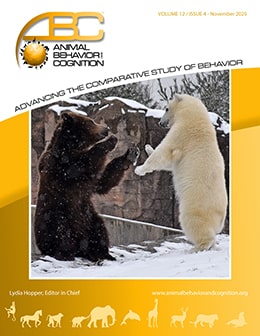Vol 12, Issue 4, November 2025
Case Studies of Bear Cub Development Under Unique Rearing Conditions
Citation
Gartland, K. N., & Fuller, G. (2025). Case studies of bear cub development under unique rearing conditions. Animal Behavior and Cognition, 12(4), 548-575. https://doi.org/10.26451/abc.12.04.05.2025
Abstract
Zoo-based polar bear (Ursus maritimus) literature is heavily biased towards reproduction and neonate development, or the behavioral management of adult individuals, often excluding the critical juvenile developmental period between den emergence and adulthood. The birth of two female cubs (Astra and Laerke) at the Detroit Zoo in 2020, and their subsequent divergent rearing conditions, offered a unique opportunity to document their development. Astra remained with her mother, Suka, to be parent-reared while Laerke was removed from Suka’s care and hand-reared due to medical necessity. Laerke was temporarily housed with a male grizzly bear (Ursus arctos horribilis) cub (Jeb), a wild-born orphan of approximately the same age, brought to the Detroit Zoo so that he and Laerke could be reared socially together. We conducted 119 hr of focal behavioral follows totaling 470 observations across a 14-month period. This allowed us to investigate Astra’s developmental trajectory and Laerke and Jeb’s behavioral responses to co-housing. Astra demonstrated increased maternal independence throughout the study period. During the period when Astra and Laerke both had access to a social partner, Laerke demonstrated higher rates of social and undesirable behaviors than Astra. However, they demonstrated no significant variation in their time spent in behaviors such as swimming, independent play, investigation, and patterns of social proximity. This monitoring also allowed us to identify when Laerke and Jeb’s developmental trajectories began to branch, and cross-species housing was no longer indicated. Documentation of these cubs and their unique housing conditions may be beneficial to institutions faced with hand-rearing cubs in the future.
Keywords
Social housing, Polar bear, Grizzly bear, Cub development, Behavior
